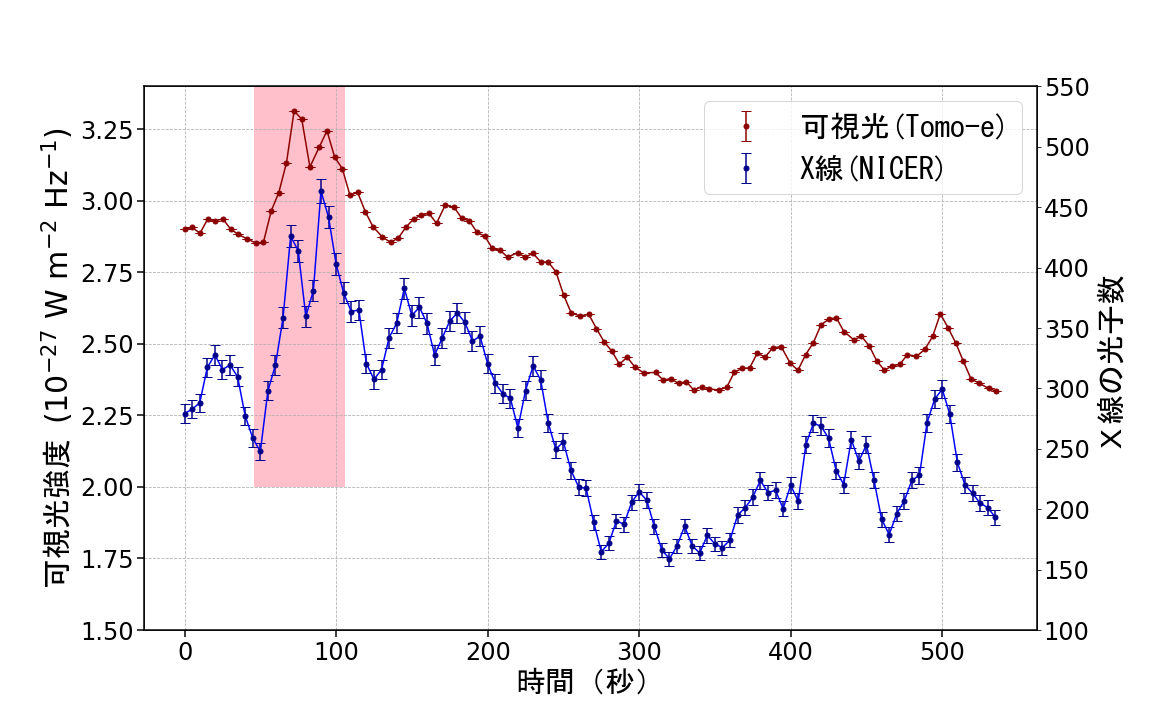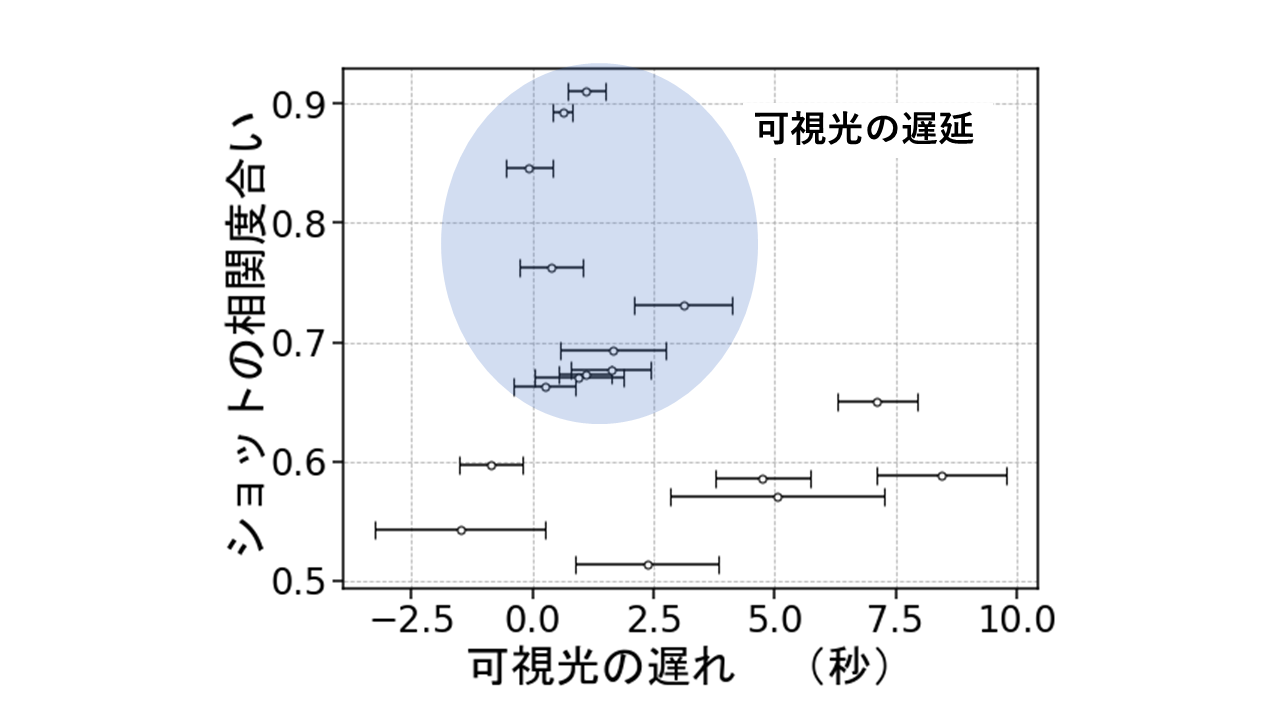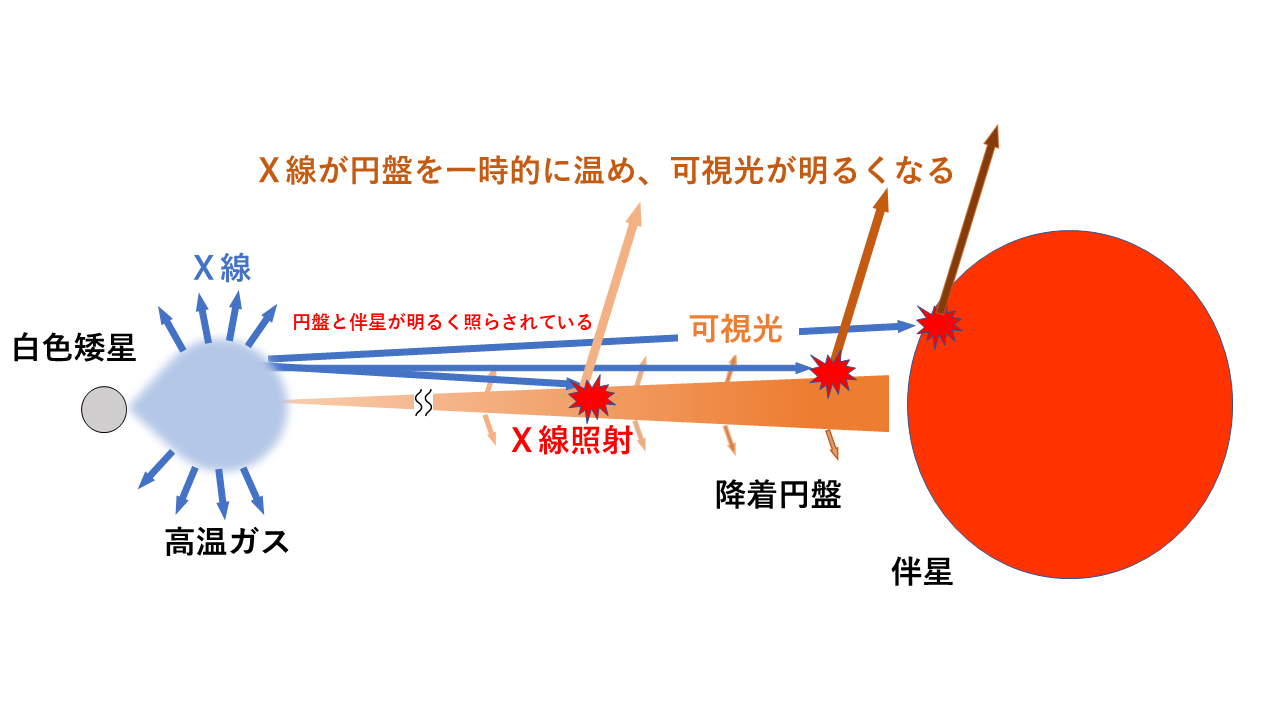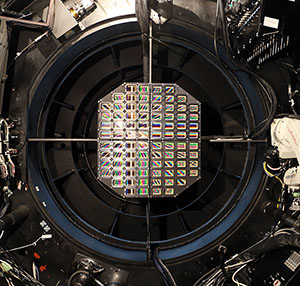DATE2022.05.18 #Press Releases
High-Speed Visible Light and X-ray Observations Reveal High-Temperature Gas Surrounding a White Dwarf
Disclaimer: machine translated by DeepL which may contain errors.
Yohhei Nishino (Department of Astronomy, 2nd year, Master's course)
Shigeyuki Sakamukai (Associate Professor, Institute of Astronomy)
Mariko Kiura (Special Postdoctoral Researcher, RIKEN)
Key points of the presentation
- Using the Kiso Observatory of the University of Tokyo's Tomo-e Gozen (Note 1) and NASA's NICER X-ray telescope (Note 2), we have performed subsecond resolution fast simultaneous observations of the dwarf nova (Note 3) SS Cyg (SS Cygnus) and found that the time variability of visible and X-ray brightness is almost synchronous.
- This phenomenon is thought to be caused by X-rays emitted from the high-temperature gas distributed in the vicinity of the white dwarf of SS Cyg, which widely illuminates the surrounding accretion disk and companion star. This suggests that the distribution of high-temperature gas in SS Cyg has recently been thickened and expanded.
- The application of our method to various types of accretion disk objects, including dwarf novae, is expected to help elucidate the structure of accretion disks that cannot be spatially resolved.
Announcement Summary
A research group led by Graduate Student Yohhei Nishino and Associate Professor Shigeyuki Sakamukai at Graduate School of Science, The University of Tokyo, and JSPS Research Fellow Mariko Kiura at RIKEN's Central Administration Bureau has used the visible light movie camera Tomo-e Gozen on the Kiso Schmidt Telescope at the University of Tokyo and NASA's The results showed that SS Cyg is a typical dwarf nova (a close binary system consisting of a white dwarf and a normal star), and that the visible light of SS Cyg is the most important factor in the formation of this system. As a result, they found a high correlation between the time variability of the visible and X-ray brightness of SS Cyg.
This high correlation is thought to be caused by the X-ray emission from the high-temperature gas (plasma) distributed in the vicinity of the white dwarf, which widely illuminates the surrounding accretion disk and companion star. When the state of the high-temperature gas changes, the surface temperature of the accretion disk and companion star, which are illuminated by the X-rays emitted from the high-temperature gas, also changes. As a result, the visible brightness of the accretion disk and the companion star changes synchronously. In previous observations of SS Cyg, the correlation between the visible light and X-ray brightness variations was not high. This finding suggests that the distribution of high-temperature gas in SS Cyg has recently been geometrically thickened and expanded, allowing it to broadly illuminate the surrounding accretion disk and companion star.
We show that a new observational technique, fast subsecond-resolution coincidence of visible light and X-rays, can be used to constrain the geometry of the accretion disk from the correlation analysis of luminosity variations.
Announcements
There are many objects with accretion disks in the universe, such as protostars, X-ray binary stars, dwarf novae, and active galactic nuclei. Accretion disks are formed when the gravitational and centrifugal forces balance each other as gas falls to the central star. The size of the accretion disk varies from object to object, but a common physical mechanism is believed to be at work. Gas loses rotational velocity due to friction during accretion onto the central star, and the frictional heat is converted into radiant energy, which emits electromagnetic waves (light). Especially when the central star is a compact and heavy object such as a white dwarf, neutron star, or black hole, the gas becomes a hot plasma state of about 10 million degrees near the central star and emits X-rays. On the other hand, the outer part of the disk is about 3,000 degrees Celsius and emits longer wavelengths of light, including visible light. Because accretion onto the central star occurs abruptly, the amount of light coming from the disk varies with time, but the mechanism of abrupt accretion is still not well understood. In order to understand the intense abrupt light intensification phenomena in the universe in a unified manner, it is required to clarify "how the gas in the disk falls into the central star" by observing the time variability of the light coming from the disk. Since disks emit light in multiple wavelength regions, simultaneous multi-wavelength observations are essential to understand the physical phenomena of the entire disk. The formation process of high-temperature gas regions in accreting disk objects and the mechanism of gas accretion from the disk to the central star have been studied theoretically, but recent advances in observational techniques have led to the detection of various light variations that cannot be explained by existing theoretical models alone.
Dwarf novae are close binary systems consisting of a white dwarf and a normal star (companion star), with an accretion disk around the white dwarf (Figure 1). SS Cyg (SS Cygnus), the subject of this study, is known as a typical dwarf nova and goes through brightening and quiescent phases with a period of about one month. SS Cyg is bright in a wide wavelength range from X-ray to visible light and has been observed by amateur astronomers as well as astronomers. Since August 2019, the quiescent brightness has been 2.5 times higher in visible light and 10 times higher in X-rays for over a year, the first time in SS Cyg's long observational history. Since high signal-to-noise ratio can be expected from this brightening, we thought that we could obtain new knowledge about accretion disc sources, and we conducted a high-speed simultaneous observation using the Tomo-e Gozen high-speed movie camera on the 105cm Schmidt telescope at the Kiso Observatory, The University of Tokyo, and the NASA X-ray telescope satellite on the International Space Station, NASA's NICER The high-speed simultaneous observations were conducted from September to November 2020 by combining the Tomo-e Gozen high-speed moving image camera on the 105cm Schmidt Telescope at the University of Tokyo's Kiso Observatory with NASA's NICER X-ray telescope on the International Space Station.

Figure 1: Artist's rendition of the dwarf nova SS Cyg (Image credit: Kiso Observatory, The University of Tokyo) SS Cyg consists of a central white dwarf, an accretion disk surrounding it, and a companion star providing gas to the disk. X-rays are emitted from the hot gas near the center, and visible light is emitted from the accretion disk and companion star. The disk and companion star are heated by X-rays emitted from the hot gas and re-emit visible light. As a result, the X-ray and visible light variations are nearly synchronized. ( High-resolution image can be downloaded here; Image credit: The University of Tokyo, Kiso Observatory)
Tomo-e Gozen and NICER share a common feature in that they are fast, second-scale observations: in the 500-second light curve acquired on September 14, 2020, red represents visible light (Tomo-e Gozen) and blue represents X-rays (NICER), clearly showing that the variations are synchronized (Figure 2). 2). This is the first time that such a high correlation between X-ray and visible light brightness variations has been detected in the dwarf nova SS Cyg.

Figure 2: Observed time variability of visible light and X-ray brightness in the dwarf novaSS Cy g.
The horizontal axis shows the delay between visible light andX-ray, and the vertical axis shows the degree of correlation (similarity) between the shots (Figure 3). Most of the highly correlated shots show a positive delay, which indicates that visible light fluctuates with a delay relative to x-rays. The length of the delay is also found to be concentrated around 1~2 seconds. No previous studies of dwarf novae have captured correlations and delays between visible light andX-rays with such subsecond time resolution. The fast simultaneous observations in this study have succeeded in capturing for the first time the rapidly changing appearance of the accretion disk.

Figure 3: Correlation between the time variability of the visible light and X-ray brightness of the dwarf nova SS Cyg. It can be seen that the time variation of visible light lags behind the time variation of X-rays by about 1 arcsecond.
The delay of the visible light variation relative to X-rays detected in this study roughly corresponds to the time it takes for light to propagate from the center of SS Cyg (the location of the white dwarf) to the outer edge of the accretion disk. This suggests that X-rays emitted from the hot gas near the center of SS Cyg irradiate and heat the surface of the accretion disk and companion star, and that the associated visible light re-emission effect is dominant (Figure 4). Past observations of SS Cyg have not detected such a high correlation between X-ray and visible light brightness variations as seen here. Therefore, the discovery of the high correlation between X-ray and visible light brightness suggests that the distribution of hot gas in SS Cyg has recently become geometrically thicker and expanded for some reason, enabling it to broadly illuminate the surrounding accretion disk and companion star. This result also supports the results of the X-ray spectral analysis in the related paper Kimura et al. (2021, PASJ, 73, 1262) by Mariko Kimura, Special Postdoctoral Researcher for Basic Sciences, and colleagues, which was published in October 2021.

Figure 4: Illustration of the geometric structure of the disk of the dwarf novaSS Cyg (cross-section viewed from the direction of the disk plane).
In previous studies of dwarf novae, X-ray spectral analysis has generally been used to put constraints on geometric structures that cannot be spatially resolved by imaging instruments on telescopes. In this study, however, we succeeded in placing constraints on the geometry of the accretion disk based solely on the analysis of visible and X-ray luminosity variations. The new method of high-speed simultaneous X-ray and visible light observations used in this study is expected to have a wide ripple effect in elucidating the geometric structure of accretion disks as well as dwarf novae, and the origin and mechanism of luminosity variations. In the future, we plan to extend the technique to more wavelengths in addition to the two X-ray and visible bands in order to elucidate the detailed structure of accretion disks.
Journal
-
Journal name Publications of the Astronomical Society of JapanTitle of paper Detection of highly correlated optical and X-ray variations in SS Cygni with Tomo-e Gozen and NICERAuthor(s) Yohei NISHINO*, Mariko KIMURA, Shigeyuki SAKO, Jin BENIYAMA, Teruaki ENOTO, Takeo MINEZAKI, Nozomi NAKANIWA, Ryou OHSAWA, Satoshi TAKITA, Shinya YAMADA, and Keith C. GENDREAUDOI Number https://doi.org/10.1093/pasj/psac027 Publication URL
Terminology
Note 1: Wide-field video camera Tomo-e Gozen
Image credit: The University of Tokyo, Kiso Observatory
The world's first wide-field movie camera for the 105cm Schmidt Telescope at the University of Tokyo's Kiso Observatory (Kiso County, Nagano Prefecture, Japan). 84 CMOS image sensors enable the camera to observe a wide area of the sky with high temporal resolution.
Image: Tomo-e Gozen, a wide-field movie camera mounted at the focus of the Kiso Schmidt Telescope. 84 sensors are lined up. https://tomoe.mtk.ioa.s.u-tokyo.ac.jp/ja/ ↑
Note 2: NICERX-ray telescope
Image credit: NASA
NASA's X-ray telescope aboard the International Space Station. It is highly sensitive to soft X-rays (relatively low-energy X-rays) and can make observations with high temporal resolution.
Image: NICER X-ray telescope aboard the International Space Station; the rectangular body slightly above the center of the image is the light-receiving part. https://heasarc. gsfc.nasa.gov/docs/nicer/↑
Note 3: Dwarf Novas and Accretion Disks
A dwarf nova is a close binary system consisting of a white dwarf and a normal star (companion star). When a portion of the gas that makes up the companion star orbits and falls toward the white dwarf (called accretion), the centrifugal force and gravity balance to form a disk-like structure called an accretion disk. The gas in the disk gradually falls inward while releasing angular momentum due to friction. This is called accretion. As the gas in the disk accretes inward, the frictional heat raises the temperature to about 3,000 degrees Celsius, and the gas glows in visible light. In the innermost region of the disk, the gas is so hot ( 10 million degrees Celsius) that it becomes plasma, from which X-rays are emitted. In particular, the structure and formation process of the high-temperature gas in the inner region of the disk are still unknown, and various proposals have been made. ↑up




